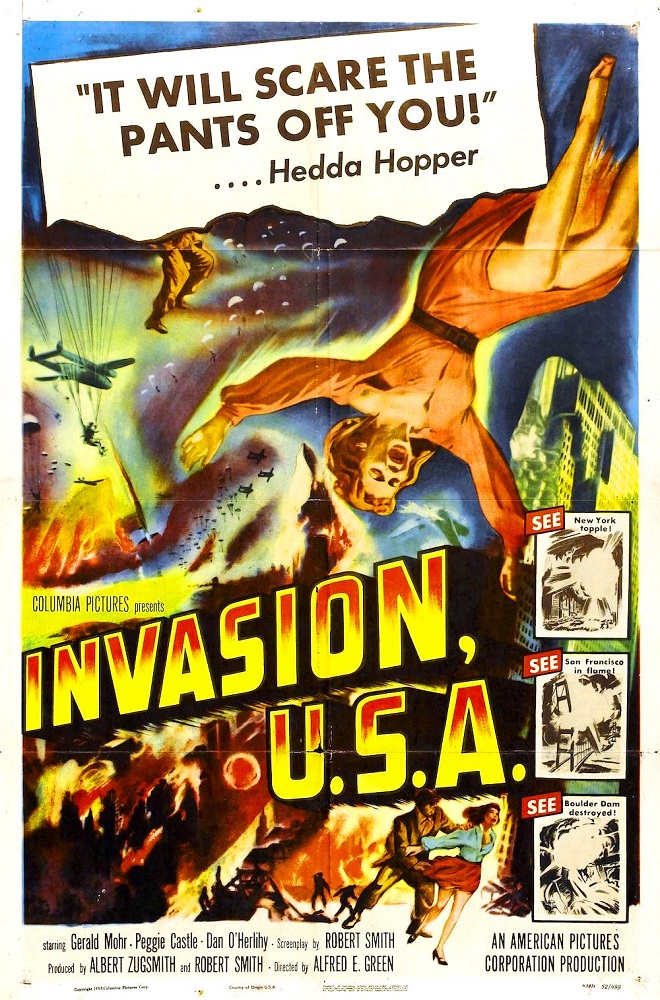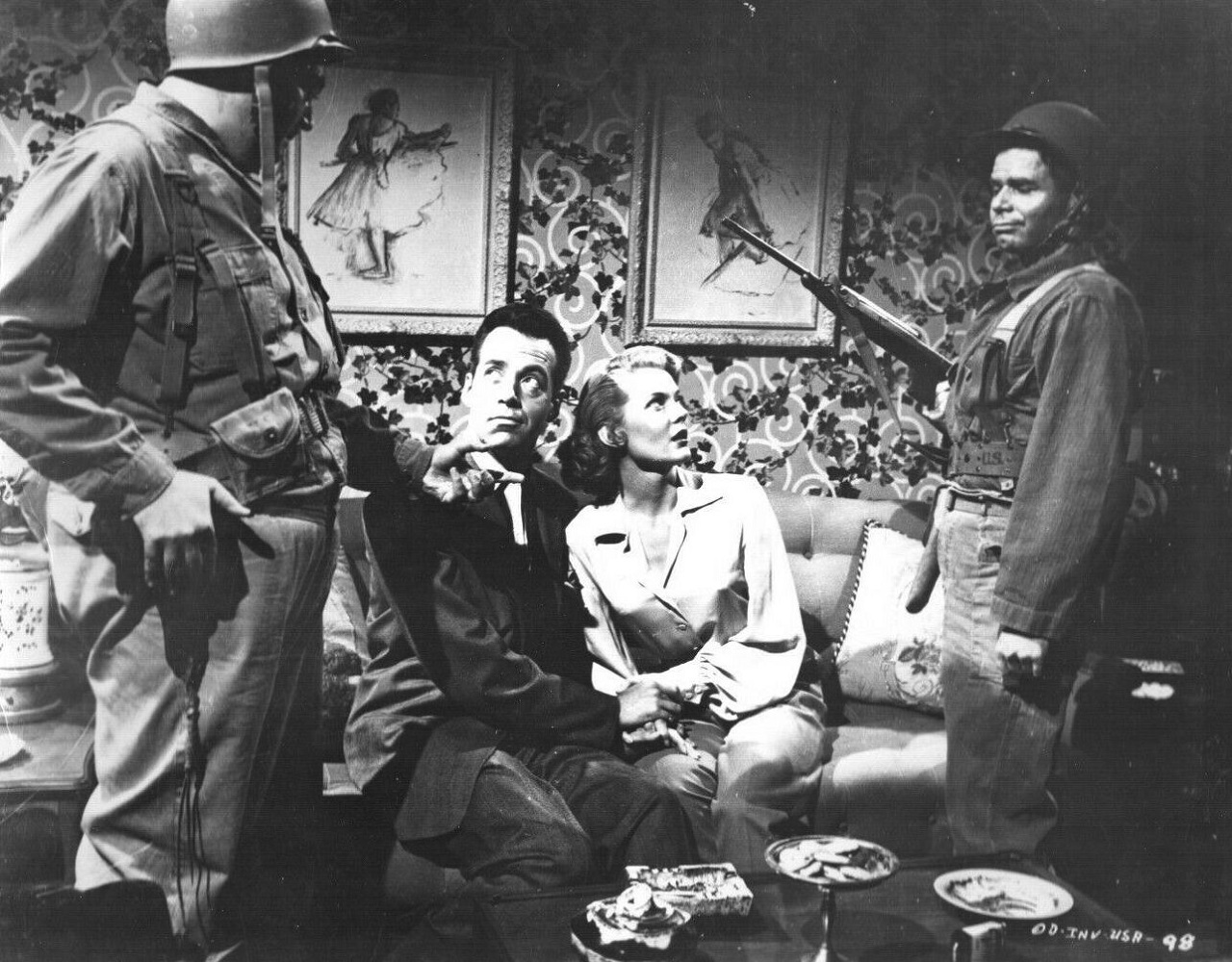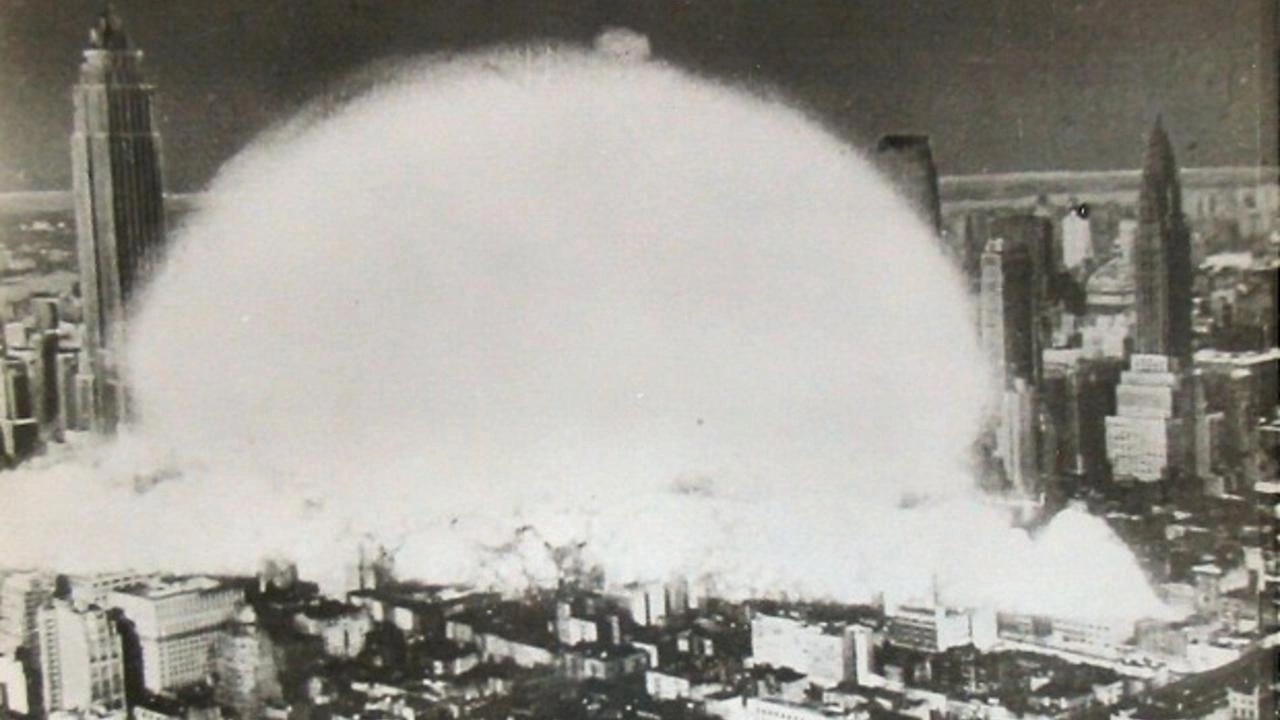
Crew
Director – Alfred E. Green, Screenplay – Robert Smith, Story – Robert Smith & Franz Spencer, Producers – Robert Smith & Albert Zugsmith, Photography (b&w) – John L. Russell, Jr., Music – Albert Glasser, Special Photographic Effects – Jack Rabin, Mechanical Effects – Rocky Kline, Art Direction – James Sullivan. Production Company – American Pictures Company.
Cast
Gerald Mohr (Vince Potter), Peggie Castle (Carla Sanford), Dan O’Herlihy (Ohman), Erik Blythe (Ed Mulvory), Robert Bice (George Sylvester), Wade Crosby (Congressman Arthur Harraway), Tom Kennedy (Tim), Aram Katcher (Communist Spy)
Plot
A group of people – tv announcer Vince Potter, cattle rancher Ed Mulvory, manufacturer George Sylvester and his date Carla Sanford, Congressman Arthur Harraway and the mysterious Ohman who says he is a ‘forecaster’ – come together in a Manhattan cocktail bar. The discussion turns to the idea of a permanent military draft. Ohman asks them all to look into his swirling brandy snifter. Just then comes news that Communist planes have invaded the northern USA and are dropping atomic bombs on all major centres. As Sylvester and Mulvory try to make their way back home to various parts of the country, Vince and Carla end up in one another’s arms. Over the next few weeks, the Communist attack pushes its way to Washington D.C. The American defence is easily decimated because Congress has allowed the American military to grow weak because of inadequate funding.
Invasion USA is a fascinating artifact from the heyday of the Reds Under the Bed hysteria in the 1950s. In fact, Invasion USA is far more of a piece of political propaganda than it ever is a dramatic work. The opening barroom scene, for example, starts in with typical conservative griping about bureaucratic interference, the evils of high taxes and big government. Overriding the scene is the question of whether there should be a permanent draft, which feels like one of those questions that must have had passions inflamed at the time the film came out, but nobody could care less about seeing the film fifty years later.
Underneath everything is a fear of Communism that borders on the hysteric. In one scene, an honest tractor manufacturer, who earlier stands up for his right to determine what his own business does, is overthrown by a Communist spy: “We don’t have to work for this capitalist anymore.” The spy is characterised as evil – he takes his former boss’s cigars and beats the man, and then proudly stands up to decide that now the factory will make tanks for the enemy government, while there is also the clear suggestion that he is Latino. It is a scene where the contrast between American-styled capitalism (which is identified with the right to determine one’s own business interests) and Communism (which determines your interests for you) is made perfectly clear. (The film conveniently seems to forget that during World War II only a few years earlier the American government conscripted various industries into making armaments).
During the climactic moments, Invasion USA contrives several scenes designed to get the red-blooded patriotic male all stirred up and angry. Communist soldiers, who are portrayed as boorish, stupid and lazy, and easily tempted by alcohol, invade the heroine’s apartment. In one rather funny scene, one of the drunken soldiers tries to force himself onto Peggie Castle but rather than submit to this, she jumps out of the window to her death (her blouse artfully torn). You get the impression that the film feels if it cannot make it points by political tub-beating then it will appeal to the basest common denominator and get the patriotic American male all worked up by the thought of lecherous Commies putting their paws on virtuous American heroines.

Of course, the clear political message that Invasion USA is trying to make – like the very similar Rocket Attack USA (1958) – is that America needs to be militarily strong against the Communist threat. The tv announcer even says so at one point – that the Communist invasion came about “all because we didn’t have a strong army.” The resentment of high taxes that we saw in the opening scene is seen as something that directly opposes Communism (for some reason, the screenwriters never seem to realise that all this greater defence spending they are calling for is something that would actually require the increase of taxes). The point is made very heavy-handedly – the politician who argued for reduced defence spending is shot down in the Capitol.
The entire film is no more than a blatant call to arms against Communism. It does provide an uncanny insight into the mentality of 1950s science-fiction and exactly the fears that lay underneath it. Indeed, substitute Martians for the invading Communists and would be very hard to tell Invasion USA apart from The War of the Worlds (1953).
The film ends with the revelation that everything we saw was only a hypnotic illusion created by Dan O’Herlihy’s mysterious stranger who symbolically calls himself Ohman (omen) and says he is a forecaster. The various parties then depart with the renewed determination to do what they must to make America strong and ensure that such never comes to pass. The film goes out on a quote from Abraham Lincoln: “To be prepared for war is one of the most effective means of preserving peace.”

While Invasion USA has been designed to make a political point, it is heavy-handed and inert as a story. The dramatic killer of the film is that it has been made on the cheap by using a good deal of stock footage of WWII aerial, naval and infantry combat to stand in for the Communist invasion. In fact, most of the film consists of people sitting around a bar watching this stock footage play out on a tv screen. This does lead to some rather funny scenes, like that of the invading Communist air force dropping atomic bombs as though they were no more than standard bomb payloads – with the amount of bombs we see being dropped, the entire US continent would surely end up a radioactive wasteland several times over.
Watching documentary-type footage of wartime combat is interesting for a time but it provides no drama or drive to the story. The viewer has no connection to what is happening – the film is not in there in the midst of the action helping us identify with the combatants, as might be the case in a war movie, for instance. There is a rather laughable sequence where the film does try to make the destruction of Colorado Dam into something exciting, but all that we get are scenes of Erik Blythe and family driving along the road in a cab, some cuts away to not terribly exciting footage of flood waters rising and then water back-projected behind the cab window, and the final laughably maudlin images of Blythe’s cowboy hat caught on a branch over the river and his daughter’s doll floating past.
Among the non-stock footage scenes that we do get, the fitful attempts at creating a romance between the two leads beleaguered in New York City are rather laughable. The romance is accompanied by some incredibly corny dialogue – “You know, it’s funny – the world’s coming to an end and you and I are sitting here and having dinner. What’s more, I was hungry.” “I know what you mean. Every once in a while I forget what’s happening in the world. I feel good. As though I had just met a new beau.” “You have.” “War or no war – people have to drink and eat. And make love.” Or “The Army doesn’t want me, the Air Force doesn’t want me, the Navy doesn’t want me,” “I want you.”
Invasion USA is not related to the action film Invasion U.S.A. (1985), which features Chuck Norris singlehandedly holding off a Russian invasion of the USA, although in terms of the political sentiments regarding the Soviet Union and their ardently red-blooded patriotism both films seem to come from remarkably similar places.
Alfred E. Green (1889-1960) directed over a hundred films from the 1910s to the 1950s in numerous different genres from dramas to Westerns to musicals. He made one other genre film with the Arabian Nights adventure A Thousand and One Nights (1945).
Full film available online here:-